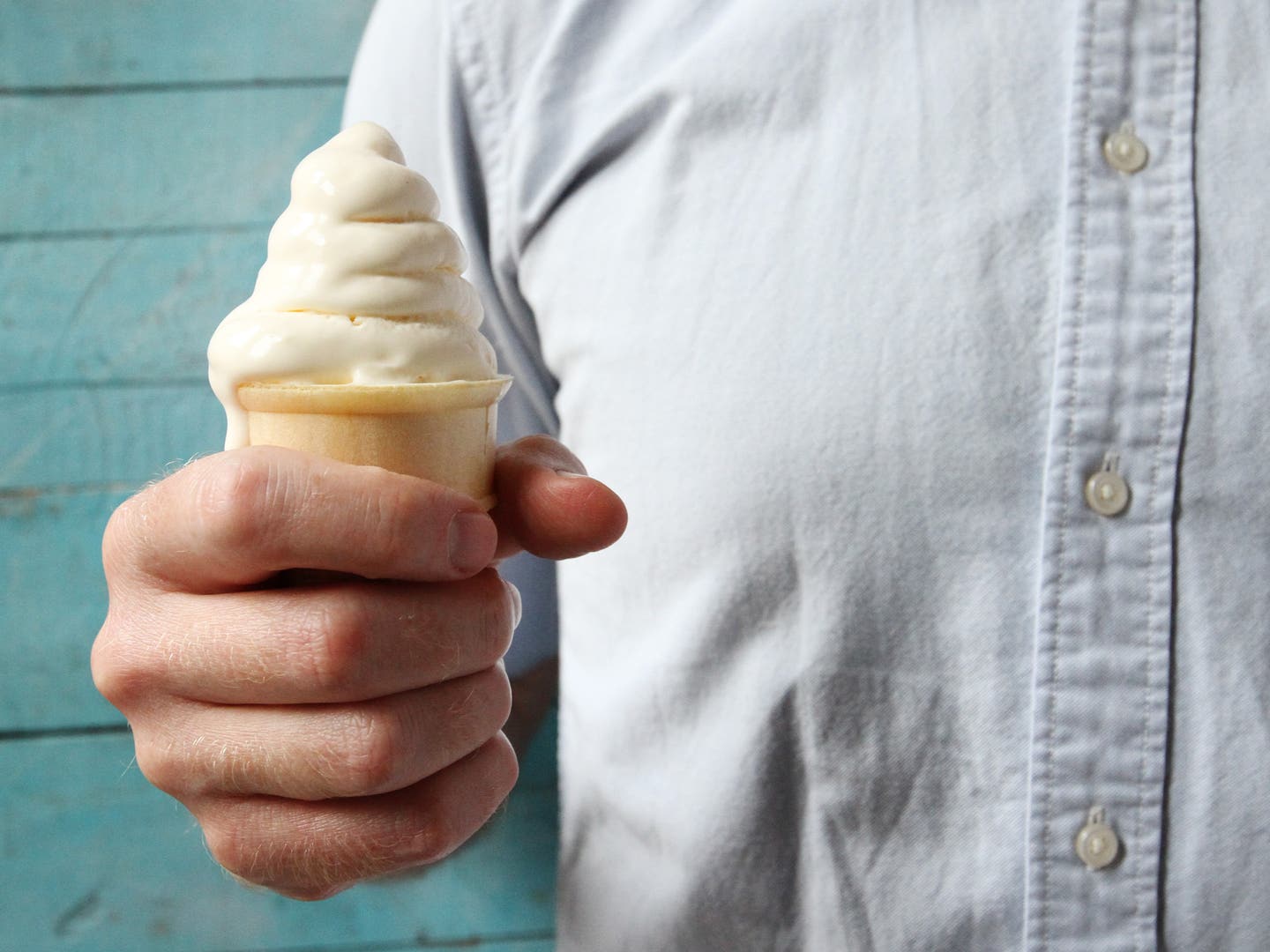
You Can’t Make Soft Serve—Unless You Hack It
The team behind Big Gay Ice Cream explains why soft serve is so difficult to DIY—but offers a cool workaround
Doug Quint and Bryan Petroff know a lot about soft serve ice cream. They're the cofounders and co-owners of Big Gay Ice Cream, the truck that first took to New York City's streets in 2009 and has now expanded to two brick-and-mortar shops in the city, plus one in Philadelphia and one opening soon in Los Angeles. With cones named things like "Salty Pimp" and "Bea Arthur," and a logo of a rainbow swirl ice cream cone, Quint and Petroff embrace quirk and kitsch, but their soft serve is no joke.
Of all the ice creams out in the world, soft serve seems to be the one that is most difficult to make at home. So we asked Quint our burning (melting?) question: Why? Here are their answers—plus their go-to recipe for hacked soft serve.
On The Difference Between Soft Serve and Regular Ice Cream
The ingredients in soft serve (GOOD soft serve) are exactly the same as those in ice cream—the biggest difference is the amount of fat. Soft serve ice cream is about 8-11% butterfat; super-premium ice cream (this is an actual USDA rating) has anywhere from 16-29% butterfat. Butterfat is necessary for both taste and mouthfeel, but too much (even that 29%) will suppress taste and make you feel like you're eating a stick of butter.
If there is too much butterfat in your soft serve mix, the machine's centrifuge action causes the butterfat to ball up and spin away from the molecules binding it. We call this “buttering out.” When you eat ice cream that has “buttered out,” you taste little pearls of legit butter. So you want to keep the soft serve mix at a butterfat level underneath the threshold of “buttering out” caused by the centrifugal force of the spinning blade.
On Soft-Serve's Soft Swirl
The next major difference between soft serve and ice cream is the amount of overrun in the two products. Overrun is the the technical name for the amount of air that is whipped into the mix. Most ice cream is at 20% overrun—the volume of the liquid is increased 20%. Soft serve is around 40%, maybe higher.
Commercial ice cream is an entirely different story. It has tons of stabilizers, and the mix can be inflated to 98% overrun. Which means that one tablespoon of mix makes 1.98 tablespoons of ice cream!
On the Realities of DIY Soft Serve
The first big issue with the idea of homemade soft serve is that a soft serve machine dispenses a product that should be eaten as soon as it is dispensed. Normal home ice cream machines contain coolant that can go a bit below freezing, but not much; commercial ice cream machines aren't all that different, but once they dispense ice cream, it then goes into a sub-zero freezer and the ice cream's temperature drops to around -29°F. You want the temperature to drop as fast as possible, to prevent ice crystals from forming and so that the ice cream maintains its structural integrity at the molecular level. Ice cream is essentially oil (fat), water, milk solids (all the stuff that floats around in milk and makes it milk, not water—proteins and such), emulsifier, and sweetener. None of those components really care for each other, so you freeze 'em quick before they start fighting.
Soft serve doesn't go into a sub-zero freezer; it comes out of the machine at about 19° F and then goes right into your mouth. That in itself makes soft serve ice cream not-so-ideal for home eating: You don't want to go through the trouble of making a mix and then not be able to store the product.
The technical deal-breaker: unlike "normal" ice cream, which in a typical restaurant machine takes 8 to 20 minutes to get from mix to frozen, a soft serve ice cream machine does the job in about 20 seconds. That takes a really serious gas coolant (called R22) and lots of electricity to power that coolant. You absolutely need a single or dual phase 220v line to get that juice flowing; and that's not something the power strip behind your fridge will accommodate!
On Your Other Options
There are a few home soft serve machines, but they are essentially toys that make cold whipped stuff. It isn’t bad, but I wouldn’t call it legit soft serve. To get “real” soft serve you need to get the ice cream down to about 19° F and do it in about a minute.
On Hacking It
If you are really craving soft serve at home, the best way to get close is to put some regular ice cream in a bowl and whip the hell out of it. You'll be fluffing the product up, essentially increasing the overrun.
In their recently published cookbook, Quint and Petroff share a recipe for "hacked" soft serve, which they learned form friend and food writer John T. Edge. All it requires is a tub of vanilla ice cream, and some extra heavy cream for good measure.
Keep Reading
Continue to Next Story










